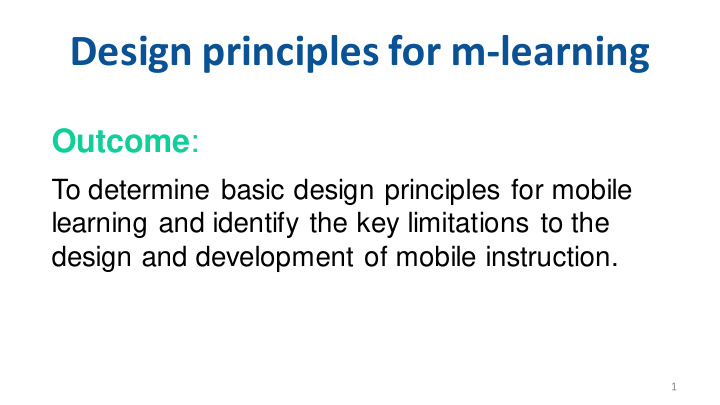



Design principles for m-learning Outcome : To determine basic design principles for mobile learning and identify the key limitations to the design and development of mobile instruction. 1
Needs Assessment Before you start the design… True need for m-learning? • What educational problem? • M-learning versus other educational solutions? • Benefits of mobile learning in the unique educational • context? Resource requirements (physical/logistic, technological, human, and • monetary)? Consider the potential enablers, challenges and risks. 2
Needs Assessment • Mobile technologies • Access to the Internet and power • Device usage and mobility patterns and context • Learning outcomes • Learner needs and preferences • Theoretical framework • Existing materials incl. educational apps 3
Key Characteristics of M-Learning Design learning experience that is: Authentic • Contextual (context-independent vs. embedded) • Collaborative, connected • Personalized • Active • Relevant and meaningful • Formal and informal • Flexible and focused • Guided by experts • Supported by experts and peers • Engaging and empowering • 4 ti t d d t t
Aspects of Design m-learning ≠ compact/ shrunk e-learning • Content (incl. learner-generated artifacts) • Delivery (incl. the physical and temporal setting) • Interaction, sharing, and communication • Learning and teaching activities 5
Content Design Multimedia • Bite-sized yet connected • Access to existing content and resources • Required and optional • Personalized and student-generated • Reminders, notifications, updates • Educational apps • Social media • …contingent on needs and context 6
Delivery Design Physical aspect (location) • context-dependent <> independent (flexible <> location-bound) – personal <> social space – quite <> loud and busy – Temporal • brief event <> series of episodes <> long activity <> course-long (continuous) – flexible <> focused – spaced-out – Technology • offline vs. online – resources web-based or residing locally – phones vs. tablets – cross-platform – social network usage – …contingent on needs and context 7
Interaction Design Individual <> collaborative Formal <> informal F2F <> via mobile devices <> blended Communication • channel and medium, e.g., text-based chat <> phlog – synchronous <> asynchronous e.g., phone call <> email – Sharing and exchange • artifacts – questions – resources – peer evaluation – peer support – …contingent on needs and context 8
Activities Design According to the type of learning (behaviourist, constructivist, situated…) More suitable for mobile: • blend focused and spontaneous tasks and activities – data collection and sharing – personal reflection – accessing resources (just-in-time, on-demand information) – connecting with the community of practice – accessing experts and supports – assessments – augmented reality tasks and games… – …contingent on needs and context 9
Activities Design Start with the learner • Educational problem >> outcomes • Technologies and unique context • Make the learning experience: • Engaging and empowering – Authentic and active – Situated and context-aware ( whenever possible ) – Be prepared for change… …contingent on needs and context 10
Recommend
More recommend